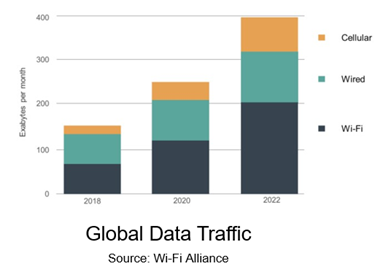Wi-Fi 7 may be closer than you think

Wi-Fi 7 may be closer than you think

Last year, Intel and Broadcom conducted the first cross-vendor Wi-Fi 7 demonstration, with an Intel-based laptop with Wi-Fi 7 connected to a Broadcom Wi-Fi 7 access point. This summer, EnGenius Technologies launched what it said was the first cloud Wi-Fi 7 access point for enterprises.
While the company (EnGenius) says it will launch products later this year, many in the industry expect that in 2024 we will start to see new standards-based and Wi-Fi Alliance certified Wi-Fi 7 products hitting the market. Even so, given the time it takes to evaluate and purchase IT products, now may be the best time for enterprises to start thinking about Wi-Fi 7.
Why are people interested in Wi-Fi 7? After all, Wi-Fi 6 and Wi-Fi 6E both bring improved performance and higher maximum throughput, but are relatively new to the market. Every standards-based enterprise device has only been widely used in recent years.
The main appeal of Wi-Fi 7 is that many of the performance enhancements and other improvements offered by Wi-Fi 6 are even more powerful in Wi-Fi 7.
What's driving the need for higher performance Wi-Fi?
The traffic carried by Wi-Fi networks has roughly quadrupled in four years. In contrast, wireline network traffic grew only slightly during the same period.

Enterprise users have been using more bandwidth-intensive applications.
Comments posted at a recent Networked Computing Editorial Webinar support this. That said, one participant noted when posing the question: “Before the pandemic, I would say 90 to 95 percent of my conference calls were dial-up calls. Post-pandemic, I haven’t made a single call. Anyway, Everything is a Zoom, WebEx, and Teams meeting, even though it can be done over the phone. Is that what others see?”
Why is this a problem? As the number of users grows and traffic increases, performance issues arise. Contention for limited bandwidth reduces bandwidth per user, increases latency, and introduces jitter. All these issues especially affect modern applications that rely on streaming data and video. User applications require more bandwidth and better responsiveness.
Wi-Fi 6 and 6E attempt to address these needs. One difference between Wi-Fi 6 and Wi-Fi 5 is that devices can take advantage of the 2.4 GHz band (in addition to the 5 GHz band supported by previous generation devices) to increase capacity. Additionally, Wi-Fi 6 supports traffic prioritization, beamforming, and Orthogonal Frequency Division Multiple Access (OFDMA) for improved performance. For example, OFDMA improves performance in dense environments by allowing smaller packets to be mixed with larger packets that may be used for video streaming. This provides a deterministic, consistent experience across the network.
Another factor is that Wi-Fi 6E-enabled devices can use an additional 1,200 MHz of spectrum in the unlicensed 6 GHz band.
According to the latest Network Computing Network Management Survey, there is currently a lot of interest in Wi-Fi 6 and 6E. The survey found that of the 336 IT manager respondents, 21% have already purchased Wi-Fi 6 and 6E equipment, 13% plan to purchase within the next 12 months, and 23% are evaluating it.
These numbers include all types of devices (endpoint devices, routers, access points, etc.). Perhaps a better indicator of the technology's importance in the enterprise is that 40% of respondents said they plan to purchase Wi-Fi 6 and 6E access points in the next year.
Others are also seeing strong demand for sixth-generation Wi-Fi. IDC predicts that two-thirds of Wi-Fi shipments this year will be Wi-Fi 6 or Wi-Fi 6E. IDC expects more growth in the coming years. “With more Wi-Fi 6 and 6E devices coming into play, the rise of Wi-Fi 7 chips in high-end devices and access points, and the trend toward more discrete Wi-Fi solutions in major client devices, all Growth is happening in layers, said Phil Solis, research director for connectivity and smartphone semiconductors at IDC, in a released statement.
Import Wi-Fi 7
Compared to Wi-Fi 6, Wi-Fi 7 will provide enterprise users with significantly higher performance and can support more users in denser environments. Li Xiang, industry solution marketing engineer at Keysight Technologies, said: "We expect Wi-Fi 6 to increase connection speeds by 4.8 times, and the maximum theoretical data rate will reach 46Gpbs." In addition, Wi-Fi 7 will provide a latency of less than 5 milliseconds . This is more than 100 times better than Wi-Fi 6. Li also noted that Wi-Fi 7 will have five times the network capacity of Wi-Fi 6.
Performance improvements like this make Wi-Fi 7 ideal for streaming applications and reducing congestion in crowded environments. As a result, more users can run more bandwidth-intensive and latency-dependent applications without performance issues. From another perspective, enterprises can support more users with fewer access points. This translates into lower administrative costs.
Wi-Fi 7's performance improvements will be attributed to several factors.
First, Wi-Fi 7 routers, access points, and devices will likely take full advantage of the 6 GHz band offered by Wi-Fi 6E.
The devices will feature new technologies including automatic frequency coordination, multi-link operation and 4K Quadrature Amplitude Modulation (4K QAM). These technologies squeeze more capacity out of wireless networks, reduce latency, and make Wi-Fi networks more responsive, some like to say, wired-like.